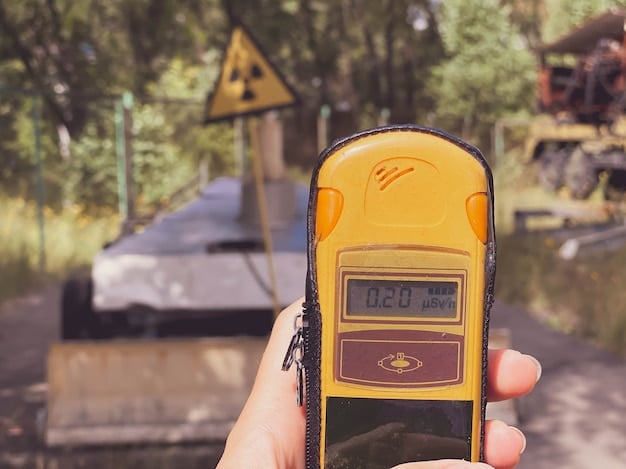Emergency Weather Kit Checklist: Stay Safe During a Disaster

An emergency weather kit checklist ensures you have essential supplies like food, water, first-aid, and communication tools to stay safe and prepared during severe weather events and other disasters.
Being prepared for severe weather events or disasters requires more than just awareness; it demands proactive measures. Creating an emergency weather kit checklist is a crucial step in ensuring your safety and well-being when faced with unexpected and potentially dangerous situations.
Why You Need an Emergency Weather Kit Checklist
Having a well-prepared emergency weather kit checklist is essential for several reasons. Disasters can strike suddenly, leaving you with little to no time to gather necessary supplies. A comprehensive emergency kit ensures you have everything you need to weather the storm, so to speak.
Moreover, during and immediately after a disaster, essential services like electricity, water, and communication networks may be disrupted. Having a kit allows you to be self-sufficient for a period of time, reducing your reliance on external aid, which may be delayed or unavailable.
Ensuring Self-Sufficiency
One of the primary benefits of an emergency kit is the ability to be self-sufficient. Stocking your kit with enough food, water, and medical supplies for at least 72 hours can make a significant difference during a crisis. This not only ensures your survival but also allows emergency services to focus on those in critical need.
Peace of Mind
Knowing you are prepared can alleviate stress and anxiety during an emergency. Having a well-stocked kit means you are ready to face whatever comes your way, reducing fear and uncertainty. This mental preparedness can be just as important as having the physical supplies.
- Quick access to supplies: Keeping all essential items in one designated place makes it easier to find what you need quickly.
- Reduced reliance on external aid: In the immediate aftermath of a disaster, external aid may be delayed or overwhelmed.
- Increased resilience: Being prepared enhances your ability to bounce back from a crisis.
In summary, maintaining a thorough emergency weather kit checklist isn’t just a matter of convenience; it’s a crucial component of personal and family safety, ensuring readiness, self-sufficiency, and peace of mind in the face of unexpected disasters.

Essential Water and Food Supplies
Water and food are fundamental to survival in any emergency situation. Ensuring you have an adequate supply of both is a critical first step in preparing your emergency weather kit checklist. Proper planning can mean the difference between enduring a crisis comfortably and struggling to meet basic needs.
Consider the specific dietary needs and preferences of everyone in your household when stocking your kit. This will help ensure that everyone has access to food they can eat and enjoy, reducing stress during an already difficult time.
Water Storage Guidelines
Water is arguably the most vital resource in an emergency. Experts recommend storing at least one gallon of water per person per day for drinking and sanitation. This means a 72-hour supply for a family of four would require 12 gallons of water.
Non-Perishable Food Choices
When it comes to food, focus on non-perishable items that require no cooking or refrigeration. Canned goods, energy bars, dried fruits, and nuts are all excellent choices. Aim for a variety of food items to provide a balanced diet and prevent food fatigue.
- Store water in food-grade containers: This will prevent contamination and ensure the water remains safe to drink.
- Rotate your food supply: Replacing items before their expiration dates ensures that your kit always contains fresh and usable goods.
- Consider dietary restrictions: Make sure your food supply meets the needs of everyone in your family, including those with allergies or medical conditions.
In conclusion, maintaining an adequate supply of water and non-perishable food is crucial for any emergency weather kit checklist, ensuring sustenance, health, and peace of mind during disasters.
First-Aid and Medical Supplies
Having a well-stocked first-aid kit is an indispensable component of any emergency weather kit checklist. Accidents and injuries can happen at any time, but they are more likely during a disaster. A comprehensive first-aid kit can help you handle minor injuries and stabilize more serious conditions until professional medical help arrives.
Regularly check and restock your first-aid kit, replacing any used or expired items. Familiarize yourself with the contents of the kit and how to use each item to ensure you can respond effectively in an emergency.
Essential First-Aid Items
Your first-aid kit should include a variety of items to address different types of injuries. Bandages, antiseptic wipes, gauze pads, adhesive tape, and pain relievers are all essential. A first-aid manual can also be helpful for guidance on treating specific injuries.
Prescription Medications and Special Needs
In addition to basic first-aid supplies, it is crucial to include any prescription medications or special medical supplies needed by members of your household. Keep a list of medications, dosages, and any relevant medical conditions in your kit.
- Include a CPR mask: This can be crucial for performing rescue breathing safely.
- Add a space blanket: These lightweight blankets can help prevent hypothermia.
- Consider adding a splint: In case of fractures or sprains, a splint can provide support and immobilization.
Ultimately, a comprehensive first-aid kit is an essential part of an emergency weather kit checklist, providing immediate care for injuries and illnesses, ensuring overall health and safety during a crisis.
Communication and Information Tools
In the midst of a disaster, staying informed and maintaining communication with the outside world can be life-saving. Including reliable communication tools in your emergency weather kit checklist is crucial for receiving updates, seeking help, and staying connected with loved ones.
Regularly test your communication devices to ensure they are functioning correctly. Keep extra batteries on hand and familiarize yourself with how each device works. Knowing how to use these tools can make a significant difference in an emergency.
Hand-Crank or Battery-Powered Radio
A hand-crank or battery-powered radio is essential for receiving weather updates and emergency broadcasts. Choose a radio that can receive both AM and FM frequencies, as well as NOAA weather alerts.
Whistle for Signaling
A whistle can be a valuable tool for signaling for help. It is louder and more effective than shouting, and it can attract attention from rescuers even in noisy environments. Attach a whistle to your backpack or keep it in an easily accessible pocket.

- Include a portable charger: This will allow you to charge your cell phone even when the power is out.
- Keep a list of emergency contacts: This list should include phone numbers for family members, doctors, and local emergency services.
- Learn basic signaling techniques: Knowing how to signal for help can increase your chances of being rescued.
In conclusion, including communication and information tools in your emergency weather kit checklist is essential for staying informed, connected, and safe during a disaster.
Shelter and Warmth Essentials
Maintaining a safe and comfortable shelter is critical during a weather emergency. The ability to regulate body temperature and create a protected space can significantly impact survival. Prioritizing shelter and warmth essentials in your emergency weather kit checklist is a fundamental step in preparing for unforeseen circumstances.
Consider the specific climate and weather patterns in your area when choosing shelter and warmth items. In colder regions, prioritize items that provide insulation and protection from the cold. In warmer regions, focus on items that offer shade and ventilation.
Emergency Blanket or Sleeping Bag
An emergency blanket or sleeping bag can provide essential warmth and insulation. These items are lightweight and compact, making them easy to store in your emergency kit. Choose blankets or sleeping bags made from waterproof and windproof materials.
Tarp or Plastic Sheeting
A tarp or plastic sheeting can be used to create a temporary shelter. It can provide protection from rain, wind, and sun. Choose a tarp or sheeting that is durable and waterproof.
- Include duct tape: This versatile tool can be used to repair tears in your shelter or to secure it to structures.
- Pack extra clothing: Include layers of clothing to adjust to changing weather conditions.
- Consider a portable heater: If you live in a cold climate, a portable heater can provide additional warmth.
To summarize, prioritizing shelter and warmth essentials in your emergency weather kit checklist is vital for regulating body temperature, providing protection from the elements, and ensuring comfort during a disaster.
Hygiene and Sanitation Items
Maintaining hygiene and sanitation is essential for preventing the spread of disease and maintaining overall health during a disaster. The disruption of normal sanitation systems can lead to unsanitary conditions, increasing the risk of illness. Including hygiene and sanitation items in your emergency weather kit checklist is crucial for protecting your health and well-being.
Consider the specific hygiene needs of everyone in your household when stocking your kit. Make sure to include items for both personal hygiene and sanitation, such as hand sanitizer and toilet paper. Regular monitoring and maintenance of hygiene supplies are important.
Hand Sanitizer and Soap
Hand sanitizer and soap are essential for maintaining hand hygiene. Use hand sanitizer after contact with potentially contaminated surfaces and before eating. Washing your hands with soap and water is even more effective when available.
Toilet Paper and Moist Towelettes
Toilet paper and moist towelettes are essential for personal hygiene. Store toilet paper in a waterproof bag to protect it from moisture. Moist towelettes can be used for cleaning when water is not available.
- Include feminine hygiene products: These are essential for women and should be included in your kit.
- Consider a portable toilet: A portable toilet can provide a sanitary waste disposal solution.
- Pack trash bags: Trash bags are essential for disposing of waste and keeping your shelter clean.
In summary, including hygiene and sanitation items in your emergency weather kit checklist is crucial for preventing the spread of disease, maintaining sanitation, and protecting your health during a disaster.
Important Documents and Personal Items
Protecting important documents and personal items is a critical aspect of emergency preparedness. Replacing these items can be time-consuming and difficult, especially during a disaster. Including a secure and waterproof container for important documents and personal items in your emergency weather kit checklist is essential for safeguarding your identity and assets.
Make sure to review and update your documents and personal items regularly. Keep copies of important documents in a secure online location or with a trusted friend or family member.
Copies of Important Documents
Include copies of important documents such as identification, insurance policies, medical records, and financial documents. Store these documents in a waterproof bag or container to protect them from damage.
Cash and Small Bills
During a disaster, electronic payment systems may be unavailable. Keep a supply of cash and small bills in your emergency kit to purchase essential items. Store the cash in a waterproof bag or container.
- Include a list of important phone numbers: This list should include phone numbers for family members, doctors, and local emergency services.
- Pack personal comfort items: These items can help reduce stress and anxiety during a disaster.
- Consider including a small photo album: Photos can provide comfort and remind you of happier times.
In closing, including important documents and personal items in your emergency weather kit checklist is essential for safeguarding your identity, accessing resources, and maintaining peace of mind during a disaster.
| Key Element | Brief Description |
|---|---|
| 💧 Water Supply | Minimum one gallon per person per day for drinking and sanitation. |
| 🍎 Non-Perishable Food | Canned goods, energy bars, dried fruits, requiring no cooking. |
| 🩹 First-Aid Kit | Bandages, antiseptic wipes, pain relievers, and personal medications. |
| 📻 Communication Tools | Hand-crank radio, whistle, list of emergency contacts. |
Frequently Asked Questions (FAQ)
▼
It is recommended to store at least one gallon of water per person per day for drinking and sanitation. A 72-hour supply is a good starting point.
▼
Focus on non-perishable items that require no cooking or refrigeration, such as canned goods, energy bars, dried fruits, and nuts.
▼
It is recommended to check and update your emergency kit at least twice a year, typically when you change your clocks for daylight saving time.
▼
Store your emergency kit in a cool, dry place that is easily accessible. A closet, basement, or garage are all good options.
▼
While all items in an emergency kit are important, water is often considered the most critical, as dehydration can quickly become life-threatening.
Conclusion
Creating and maintaining an emergency weather kit checklist is a crucial step in ensuring your safety and well-being during a disaster. By following the guidelines and recommendations outlined in this article, you can assemble a comprehensive kit that meets your specific needs and provides you with the resources you need to weather any storm.





